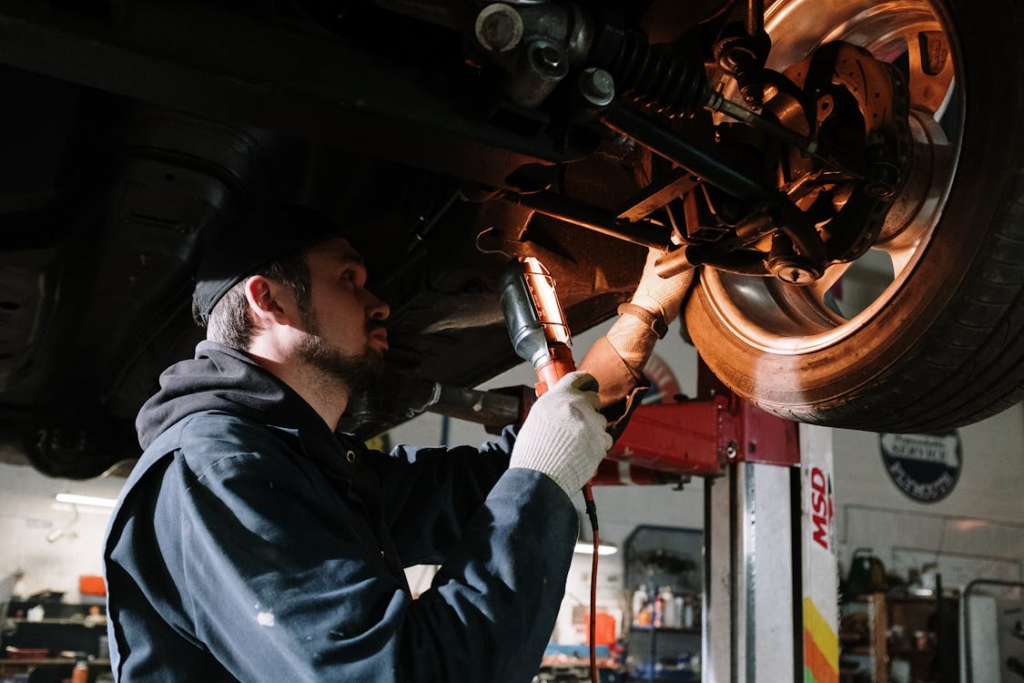How to Identify and Address Brake Problems Early
Brakes are one of the most important safety features on your vehicle. Whether you’re coming to a smooth stop at a red light or slamming the brakes in an emergency, your braking system needs to perform reliably every time. But here’s the thing—brake problems rarely appear out of nowhere. They tend to show early warning signs long before complete failure. The key is knowing what to look for and acting quickly.
In this guide, we’ll walk you through the early signs of brake trouble, what they mean, and how to address them before they become costly—or dangerous—repairs.

Why Brake Health Matters
Imagine driving down a busy street and suddenly realizing your car isn’t stopping as quickly as it used to. That’s a terrifying moment—and one that’s entirely avoidable with proper brake maintenance. Your vehicle’s braking system is not just about stopping power; it’s about control, confidence, and safety.
Over time, your brakes experience wear from heat, friction, and constant use. Ignoring early signs of wear can lead to longer stopping distances, uneven braking, or complete system failure. And when it comes to brakes, even small issues can escalate fast.
Common Warning Signs of Brake Trouble
Here’s what to keep an eye (and ear) out for:
1. Squeaking or Squealing Sounds
One of the earliest signs of brake wear is a high-pitched squeak when you press the brake pedal. Most modern brake pads have a built-in metal indicator that creates this noise to alert you when it’s time for a replacement.
What it means: Your brake pads are wearing thin.
What to do: Get them inspected right away. Replacing pads is quick and affordable compared to the damage worn pads can do to your rotors.
2. Grinding Noise
If your brakes are making a grinding noise, that’s a red flag. It usually means the brake pads are completely worn out, and metal is scraping against metal.
What it means: The pads are gone, and your rotors may already be damaged.
What to do: Stop driving and have your car inspected immediately. Continuing to drive can lead to severe rotor damage and dangerous brake failure.
3. Vibrations or Pulsations
If you feel vibrations in the brake pedal or steering wheel while braking, it may be due to warped rotors.
What it means: Heat and pressure have caused the rotors to lose their smooth surface.
What to do: Rotors may need to be resurfaced or replaced. Ignoring this issue can lead to uneven braking and loss of control.
4. Brake Warning Light
If your brake warning light appears on the dashboard, don’t ignore it. This light can be triggered by low brake fluid, worn brake pads, or issues with the hydraulic system.
What it means: Your car’s computer has detected a problem in the braking system.
What to do: Have a technician run a diagnostic scan to pinpoint the issue. It might be as simple as topping off brake fluid, but it could be more serious.

5. Spongy or Soft Brake Pedal
If your brake pedal feels soft or sinks to the floor when pressed, that’s a serious issue.
What it means: There could be air in the brake lines, or worse, a leak in the hydraulic system.
What to do: Don’t drive the vehicle until it’s checked by a professional. A compromised hydraulic system can lead to complete brake failure.
6. Burning Smell
A sharp, chemical odor after heavy braking (like going down a long hill) could indicate overheated brakes or even a stuck caliper.
What it means: Your brakes are overheating, which can lead to system damage or failure.
What to do: Pull over safely and let the brakes cool. If the smell continues, have them inspected—especially if it’s accompanied by smoke.
Causes of Brake Wear and Failure
Understanding why brake problems happen helps you prevent them. Here are some common causes:
- Worn brake pads: They’re designed to wear out and need regular replacement.
- Driving habits: Hard braking, heavy loads, and stop-and-go traffic increase wear.
- Neglected maintenance: Skipping regular inspections allows problems to grow unnoticed.
- Brake fluid contamination: Moisture in the brake fluid reduces effectiveness and damages internal components.
How to Address Brake Problems Early
The best way to prevent serious brake issues is to stay proactive. Here’s how:
1. Get Regular Brake Inspections
At Vancouver Auto Centre, we recommend a brake check at least once a year—or every 12,000 miles—whichever comes first. Inspections help catch wear before it becomes a problem.
2. Listen to Your Car
Unusual sounds, smells, or sensations are your car’s way of telling you something’s wrong. Don’t brush off these signs.
3. Replace Brake Pads on Schedule
Most brake pads last between 25,000 to 70,000 miles, depending on driving conditions. Don’t wait until they’re squealing or grinding.
4. Flush Brake Fluid
Brake fluid absorbs moisture over time, which can corrode parts and reduce performance. A brake fluid flush every 2 years (or as recommended by your car’s manufacturer) keeps your hydraulic system healthy.

5. Address Issues Immediately
Brake issues only get worse—and more expensive—the longer you wait. Acting early can save you from higher repair costs and keep you safer on the road.
How We Can Help at Vancouver Auto Centre
At Vancouver Auto Centre, brake inspections and repairs are part of our everyday commitment to keeping your car running safely. With 15 years of trusted experience, our team knows how to spot early signs of trouble before they impact your driving. Whether it’s noisy brakes, worn pads, or hydraulic issues, we’ll walk you through every step clearly—no confusing lingo, no surprise costs.
From modern sedans to classic cruisers, we use advanced diagnostic tools to make sure every brake job is done right. Plus, we back our work with integrity and transparency—just the way it should be.
